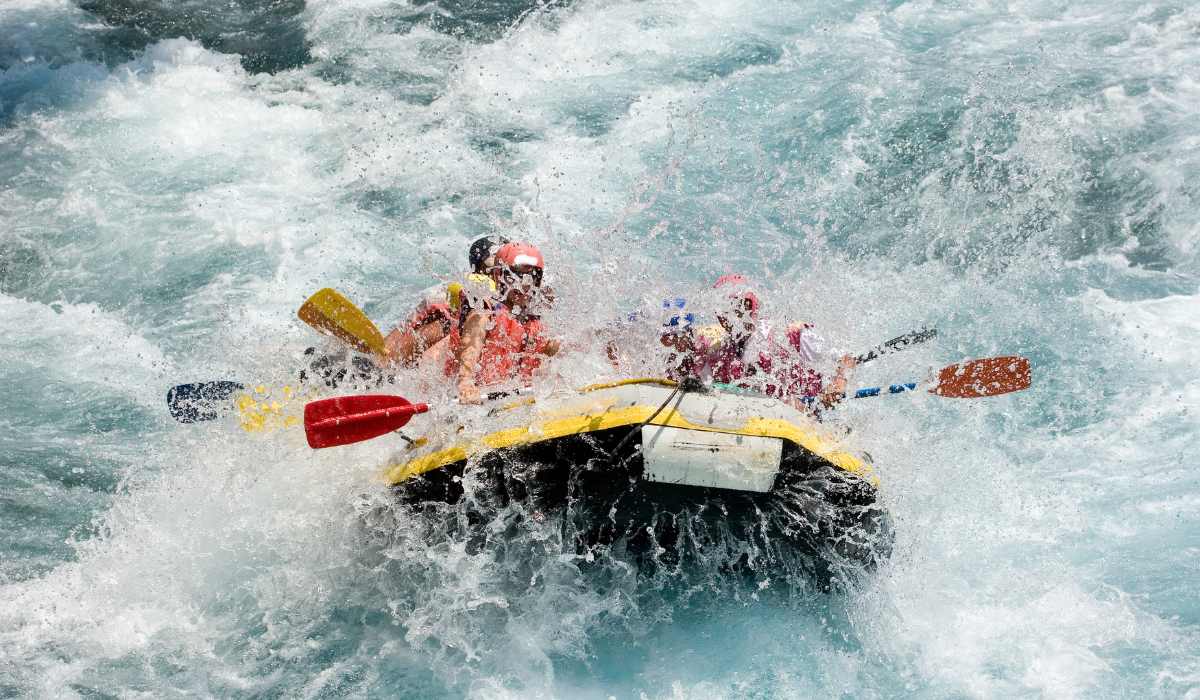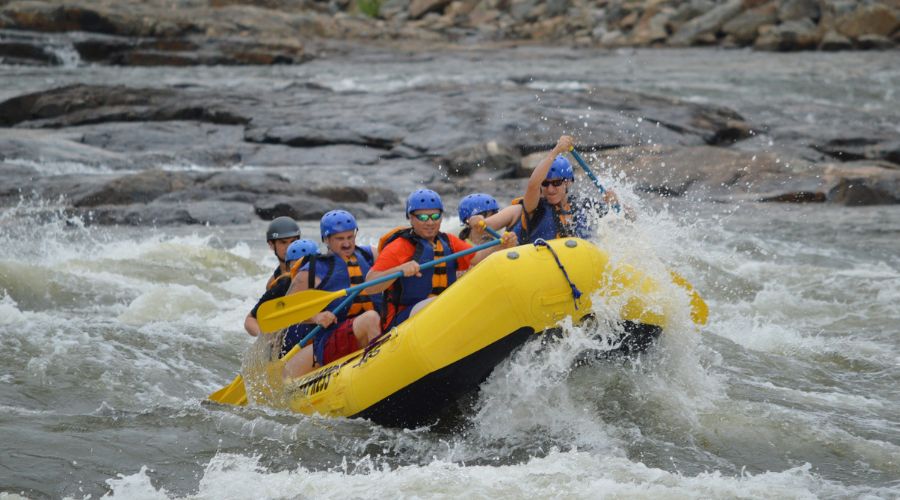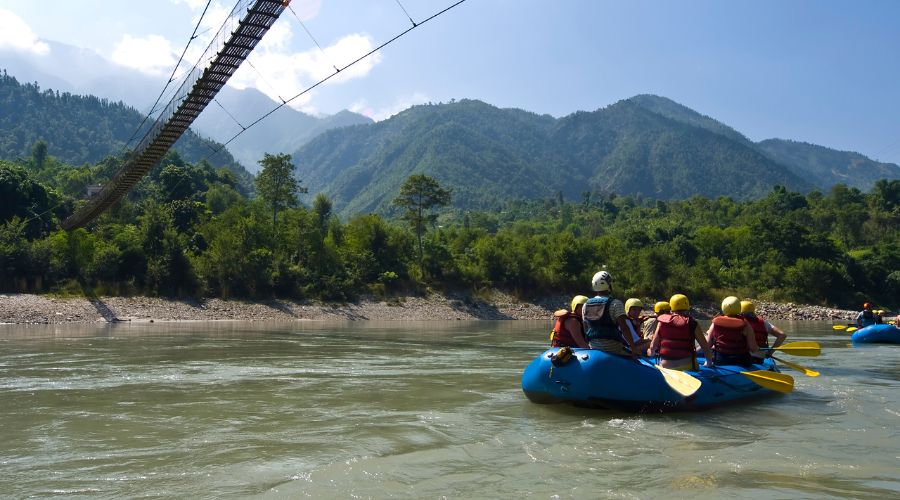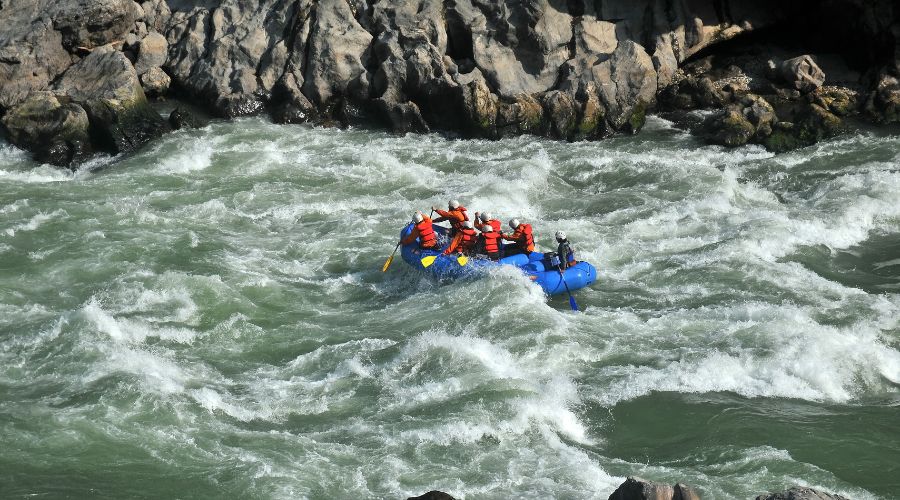
Rafting in Nepal: A Complete Guide

Rafting in Nepal: A Complete Guide
swotah travel
2769
10, 02 2023
Will it not be adventurous if you raft along the fast-flowing rivers? It sure will be. Rafting comes as one of the forms of adventurous activity that has been done throughout the decades. This water-based activity guarantees an unforgettable adventure full of excitement. The raw power of nature and the beauty of picturesque landscapes as you navigate through the rapids are indescribable in words. You can paddle through untouched waters while surrounded by towering cliffs and rich green vegetation.
Besides serving as a mode of transportation, rafting on a river is an exhilarating experience testing one's endurance and creates lasting memories. Are you ready to take on such a bold adventure?
What Is River Rafting?
River rafting is an adventure activity where you will set off on a pulsating journey through Nepal's wild and rugged rivers. This heart-pounding outdoor activity provides a distinctive blend of adventure, rapids, and delight as you travel the wild waters using a raft.

As the demand for heart-pumping outdoor activities has increased, white water rafting has seen a surge in popularity, and Nepal offers an unparalleled selection of challenging rivers. As one of the wealthiest nations in terms of water resources, Nepal's rivers are home to a plethora of whitewater rapids, classified into six categories.
Most river rafting expeditions are designed to travel through class 3 and 4 rapids, providing an exciting ride while ensuring the safety of the guests. But the experience is not just limited to the rush of adrenaline - it also opens up the opportunity to explore remote landscapes and lesser-known river routes that are otherwise inaccessible by road.
River rafting is suitable for beginners as well as experienced ones, as it requires almost no effort from the rider besides the ability to swim.
Thrill-seekers of all proficiency levels can safely experience the rush of adrenaline through this popular outdoor sport, guided by seasoned instructors who cater to all levels. Rafting is made up of specialized rubber rafts that are very sturdy and flexible. Equipped with paddles, participants can actively guide and move their raft, adding a dynamic element of participation to the adventure.
Pre-Trip Preparation and Safety Tips
White water rafting is an enjoyable adventure for different ages. However, it can also be quite demanding, requiring a certain physical and mental courage.
-
First, equip yourself with the essentials for your rafting adventure. While shopping, remember to buy Light elastic slippers and shorts, as they are suitable for a relaxed and comfortable adventure in the water.
-
To guarantee the safety and welfare of all individuals involved, it is compulsory that proper safety equipment, specifically helmets, be worn at all times. The water is packed with hazards, such as submerged rocks, logs, and branches, that may not be visible while seated in the boat. To prevent head injuries, wearing helmets and taking appropriate precautions to reduce risk consistently is compulsory.
-
Before engaging in outdoor activities such as rafting, remember to apply sunscreen daily to protect yourself from Uv rays.
-
A life jacket is another important piece of equipment for anyone engaging in a rafting adventure. Therefore, it provides a buoyant barrier against drowning. The life jacket has a floating property which helps while drowning in the water. The life jack will lift your body, so wear your life jacket correctly and comfortably.
-
Use the T grip properly: To use the T-grip effectively, position one hand at the base of the paddle on the shaft while the other should be situated atop the T-grip. T- grip ensures that the paddle does not slip out from your hand and hit you or your partners while rafting. The t-grip is the paddle that usually looks Like a "T" shaped and is made of hard plastic.
Classes of Rapids and Instructions on How to Navigate Them
There are altogether 6 classes of Rapids.
Class I: Class I rapids are regarded as the easiest level of rapids to navigate. They are typically suitable for beginners and experienced paddlers alike. Small, easy-to-maneuver waves and a low risk of capsizing characterize them. Class I rapids are often described as "flatwater with ripples" or "easy-moving water."
Class II: These rapids are generally considered a step up in difficulty from Class I rapids, the easiest type to navigate. They typically have more pronounced currents and waves and may require some basic guide to navigate safely.
Class III: These types of rapids are considered intermediate in difficulty and require a moderate level of skill to navigate safely. The waves, currents, and eddies can be unpredictable and can cause the kayak to topple if the paddler is not prepared.
Class IV: These rapids are considered advanced in difficulty and require a high level of skill and experience to navigate safely.
In addition to the physical hazards, Class IV rapids can have strategic considerations, such as complex and challenging routes through the rapids and many obstacles like holes, drops and constricted passages.
Class V: These rapids are considered expert-level in difficulty and are the most challenging rapids to navigate. Be aware of any drops you may encounter, as they possess powerful and ineluctable waves and whirlpools. Eddies are scarce, isolated, insignificant, turbulent – and hard to approach.
Class VI: Class VI rapids are considered the most challenging and dangerous rapids on a river. Violent and unpredictable currents, large and unavoidable rocks, and steep drops typically characterise them. These rapids are generally considered to be unrunnable by most kayakers and rafters and are usually only attempted by expert whitewater boaters with years of experience.
Top Places For Rafting In Nepal
Trishuli River
Trishuli River is one of the best getaways for river rafting in Nepal. It comes under the 3+ grade in the river rafting category. Your rafting starts from Benighat, a village in Dhading. From there, you will raft down into the river to the ending point in Muglin, where Marshyangdi and Trisuli meet to form Narayani. If you are a Nepali citizen, it costs around 2500 NPR per person. The cost for international travelers might be more than the normal one.
The fast-flowing current of the Trishuli river makes your rafting experience memorable. You will get a set of instructions from your boat guide, who will be present in the same boat you are on throughout the rafting.

Bhotekoshi River
Bhotekoshi is one of the fast flowing rivers in Nepal best for adventurous river rafting. This river has a grade of 3-4 in the rafting category.
The rafting starts from Khadichaur in Sindhupalchok district from where you will raft down to Kolpa. After staying overnight at Kolpa, your next rafting session begins down to Dumja, which is the ending point of the Bhotekoshi river rafting package.
The cost of Bhotekoshi river rafting has a varied form. It costs $97 for the group of 5, $100 for 4, $110 3, and $120 for two passengers on the boat.

Kaligandaki River Rafting
Kaligandaki river rafting is the moderate rafting tour which has the grade of 3+ in the rafting category. This adventurous rafting starts from Maldhunga, Baglung and ends in Mirmi in Syangja.
You will need river permits, gear raft support, and medical kits throughout the rafting session, which will be provided by the campaigners, where you book your rafting. The average cost of Kaligandaki River rafting is $110.
Besides these famous spots, there are several other destinations for rafting, including Sun Kosi River, Karnali River, Upper Seti, Marshyangdi, Tamor, and other fast flowing streams.
Equipping Yourself With the Right Rafting Gear
You should be prepared with the correct gear for a successful and delightful whitewater rafting adventure. The particular gear you'll need to bring is contingent on the form of rafting you plan on doing and the state of the river. However, a few elemental items must always be with you.
Here is a list of some essential rafting gear that you should consider bringing with you on your trip:
A PFD, also known as a life jacket, will help lift your body in water if you are drowning.
1. Personal flotation device (PFD): A PFD, also known as a life jacket, will help you to lift your body in water if you are drowning.
2. Helmet: The helmet is another essential gear to protect your head from falls or collisions during your adventure. Look for a helmet specifically designed for whitewater rafting that fits snugly on your head.
3. Wearing a wetsuit or drysuit designed in such a way so that you won't feel cold from the waters during your adventure. Make sure to choose a suit that is suitable for the temperature of the water and that fits comfortably.
4. Spray jacket or splash top: A spray jacket or splash top can help keep you dry and comfortable while rafting.
5. Paddle: The outcome of your excursion depends upon a suitably dimensioned and calibrated paddle. Along with the right size, ensure your paddle's feathering can be adjusted depending on conditions.
6. Footwear: Pack closed-toe shoes with a good grip designed for water sports activities.
7. Throw bag: A throw bag contains buoyant ropes used to rescue people or equipment from water. It is one of the main tools used by professional guides during rafting.
8. First Aid kit: Wherever you go, remember to pack a first aid kit in emergencies. Ensure the kit includes basic items like band-aids, gauze, pain relievers and more specialized items like a snakebite kit or a portable defibrillator.
Local Stories, Culture, and Cuisine Along Nepal's Rivers
The rivers that flow through Nepal are integral to the local stories, culture, and cuisine. You can uncover the rich cultural heritage of the indigenous populations as you meander along the Trisuli river's edge.
Travelling through the core of Nepal, the Trishuli River has become a renowned location for rafting among enthusiasts. The mighty river has been an integral aspect of the inhabitants of this region, with mythology and tales passed down through the generations offering a glimpse into their rich cultural heritage and customs. You can enjoy local and traditional foods like dal bhat, a staple dish made from lentils and rice, and momos, a popular dumpling in this region.
Nepal's western region boasts yet another prime location for rafting enthusiasts - the Seti River. Famous for its awe-inspiring gorges and picturesque landscapes, crossing the Seti River via raft offers a thrilling adventure. Along the journey, one can immerse themselves in the local culture and gain insight into the lives and tales of the area's residents.
The Seti River region boasts a vibrant culinary landscape, bragging about an array of traditional dishes such as gundruk, a fermented vegetable delicacy, and Dhedo, a hearty porridge crafted from millet or corn. The rivers of Nepal, ranging from the Trishuli to the Seti, present a plethora of opportunities for an unforgettable journey for any wanderer.
The river has both fast and calm parts, offering many different experiences. You can find excitement and new things on the river, from the rough rapids to the peaceful areas through river rafting. The guides who know the river very well from the inside out will ensure your trip will be safe and unforgettable.
NEWSLETTER SIGNUP
Sign up to receive our trip ideas and travel offers!
Get updates and Exclusive Offers up to 20% Discount








